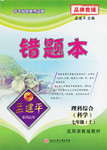


 灵星计算小达人系列答案
灵星计算小达人系列答案 孟建平错题本系列答案
孟建平错题本系列答案科目:高中英语 来源:2012-2013学年江苏省沭阳县高二下学期期中调研测试英语试卷(带解析) 题型:阅读理解
Albert Szent-Gyorgyi was born in Budapest on September 16, 1893. In 1911 he entered his uncle’s laboratory where he studied until the outbreak of World War One, when he joined the army. He served on the Italian and Russian fronts, and he was permitted to leave the army in 1917 after being wounded in action. He completed his studies in Budapest before he went to Hamburg for a two-year course in physical chemistry. In 1920 he became an assistant at a university in Leiden, the Netherlands and from 1922 to 1926 he worked with H. J. Hamburger at the Physiology Institute, Groningen, the Netherlands.
In 1926, Szent-Gyorgyi was ready to end his own life after an embarrassing problem in his career. The scientist, thirty-two, had written a paper and handed it to his boss for approval to publish. His boss threw it in the dustbin. Concluding his life was a failure, the young researcher quit. Unable to support his wife and child, he sent them home to her parents. His final wish was to attend one last scientific meeting, to be among scientists, to have one last good time. So he went to the 1926 International Physiological Society Congress in Sweden.
Sitting in the audience, lost in self-pity, Szent-Gyorgyi listened to the president of the society, Sir Frederick Gowland Hopkins, refer to the fine work of a researcher: Szent-Gyorgyi! After the speech, collecting his courage, he introduced himself to Hopkins. The great man invited the young scientist to Cambridge to do further work.
Szent-Gyorgyi’s life changed. He discovered the oxidation-preventing (防氧化的) action of vitamin C. He won the Nobel Prize in Physiology or Medicine in 1937. He accounted for his success by saying that discovery is seeing what everyone else has seen but thinking what nobody else has thought.
【小题1】Which of the following is the correct order of the events relevant to Szent-Gyorgyi?
a. finished his studies in Budapest
b. served during World War One
c. worked with Hopkins
d. studied in Hamburg
| A.b, c, a, d | B.b, a, d, c | C.a, c, d, b | D.a, b, d, c |
| A.His pride was hurt by his boss. |
| B.He was not satisfied with his paper. |
| C.He couldn’t support his family. |
| D.His boss stopped him attending a conference. |
| A.cause and effect |
| B.comparison and contrast |
| C.time and events |
| D.definition and classification |
查看答案和解析>>
科目:高中英语 来源:2014届江苏省沭阳县高二下学期期中调研测试英语试卷(解析版) 题型:阅读理解
Albert Szent-Gyorgyi was born in Budapest on September 16, 1893. In 1911 he entered his uncle’s laboratory where he studied until the outbreak of World War One, when he joined the army. He served on the Italian and Russian fronts, and he was permitted to leave the army in 1917 after being wounded in action. He completed his studies in Budapest before he went to Hamburg for a two-year course in physical chemistry. In 1920 he became an assistant at a university in Leiden, the Netherlands and from 1922 to 1926 he worked with H. J. Hamburger at the Physiology Institute, Groningen, the Netherlands.
In 1926, Szent-Gyorgyi was ready to end his own life after an embarrassing problem in his career. The scientist, thirty-two, had written a paper and handed it to his boss for approval to publish. His boss threw it in the dustbin. Concluding his life was a failure, the young researcher quit. Unable to support his wife and child, he sent them home to her parents. His final wish was to attend one last scientific meeting, to be among scientists, to have one last good time. So he went to the 1926 International Physiological Society Congress in Sweden.
Sitting in the audience, lost in self-pity, Szent-Gyorgyi listened to the president of the society, Sir Frederick Gowland Hopkins, refer to the fine work of a researcher: Szent-Gyorgyi! After the speech, collecting his courage, he introduced himself to Hopkins. The great man invited the young scientist to Cambridge to do further work.
Szent-Gyorgyi’s life changed. He discovered the oxidation-preventing (防氧化的) action of vitamin C. He won the Nobel Prize in Physiology or Medicine in 1937. He accounted for his success by saying that discovery is seeing what everyone else has seen but thinking what nobody else has thought.
1.Which of the following is the correct order of the events relevant to Szent-Gyorgyi?
a. finished his studies in Budapest
b. served during World War One
c. worked with Hopkins
d. studied in Hamburg
A.b, c, a, d B.b, a, d, c C.a, c, d, b D.a, b, d, c
2. Why did Szent-Gyorgyi want to end his own life in 1926?
A.His pride was hurt by his boss.
B.He was not satisfied with his paper.
C.He couldn’t support his family.
D.His boss stopped him attending a conference.
3. The passage is organized in the pattern of _____________.
A.cause and effect
B.comparison and contrast
C.time and events
D.definition and classification
查看答案和解析>>
湖北省互联网违法和不良信息举报平台 | 网上有害信息举报专区 | 电信诈骗举报专区 | 涉历史虚无主义有害信息举报专区 | 涉企侵权举报专区
违法和不良信息举报电话:027-86699610 举报邮箱:58377363@163.com